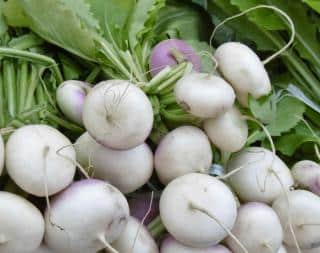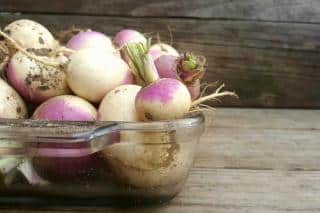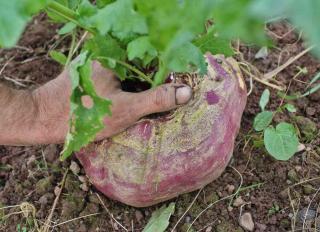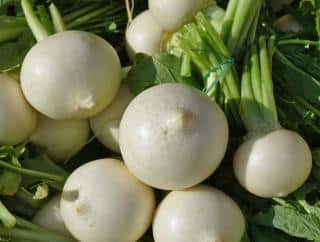

Native to Eastern and Northern Europe, the turnip or Brassica napus is a root vegetable that has long been appreciated for its culinary appeal and for its health benefits, too.
Its edible leaves sprout into flowers that can reach 2 feet (60 cm) in height.
<!–silent
–>
Considered a “basic vegetable” like the carrot and leek, turnip belongs to the same family as cabbage.
Native to Eastern Europe, the first historical hints that turnips were known go back to the neolithic ages. Together with parsnip, turnips are among the oldest cultivated food staple roots.
The root of the turnip is very fleshy, even if it grows in many very surprising shapes like round, elongated or flat.
Today, it is produced in most of the temperate climate countries.
 Turnip is popular thanks to its emollient and softening properties. It is sometimes also used against chest diseases (chronic loaded airways, asthma, pertussis).
Turnip is popular thanks to its emollient and softening properties. It is sometimes also used against chest diseases (chronic loaded airways, asthma, pertussis).Did you know…?
 Herbal tea: either prepare a decoction from the root or a leaf infusion, both prepared with 3.5 oz (100 g) of plant material for 1 quart (1 liter) water.
Herbal tea: either prepare a decoction from the root or a leaf infusion, both prepared with 3.5 oz (100 g) of plant material for 1 quart (1 liter) water.
Juice: blend the entire plant, and drink 3.5 oz (100 g) a day to fight anemia.
Syrup: boil one pound (500 g) of turnip in 2 quarts (2 liters) water. Filter, add 35 oz (1 kg) sugar and boil down to syrup. Against painful racking cough.
Warm poultice: use the flesh of the turnip.
 A part sun exposure is what is best for your turnips to grow well, since strong heat hollows them out and make them more fibrous. As for the soil, it should be loamy, even cool clay is fine as long as it doesn’t stay waterlogged.
A part sun exposure is what is best for your turnips to grow well, since strong heat hollows them out and make them more fibrous. As for the soil, it should be loamy, even cool clay is fine as long as it doesn’t stay waterlogged.
Watch out for chalk, if there is too much of it, productivity and quality will decrease.
Persons with weak stomachs will prefer younger turnips, which are easier to digest since they contain less sulfur.
Potted turnips? If you have access to flat varieties, it is possible to plant them in pots at least 12 inches (30 cm) deep.
Watch out for small bugs! Cabbage fly, turnip fly, flea beetles, cabbage moth, turnip-sawfly and slugs… ouch! They all hurt!
Summer and spring turnips, to sow from March to June:
Fall and winter turnips, sowing June to August:
Turnips for forcing to sow in February-March:
 Turnips are eaten cooked, as a side dish to meat (fowl, duck) and also mashed in puree, radish and turnip leaf soup, beef stew, mixed vegetables. It can also be eaten raw, simply grated (better with young turnips).
Turnips are eaten cooked, as a side dish to meat (fowl, duck) and also mashed in puree, radish and turnip leaf soup, beef stew, mixed vegetables. It can also be eaten raw, simply grated (better with young turnips).
Good to know: young leaves are prepared just like spinach leaves, or they can simply be added into soup!
21 kcal / 3.5 oz (100 g). Turnip has a lot of vitamin C, B3 and B6, fiber and trace elements (iron, potassium and calcium). It relaxes and is a diuretic.
Turnips are often spurned away by many, and it is truly unfair. Young and tender, with its cute pink cheeks, it is excellent when eaten young. In spring French lamb stew, presented around roasted chicken with carrots and turnips, or candied with white onions… Even steam cooking does wonders when you can lather it with butter. It will make your taste buds rejoice!
Blandine Merlin